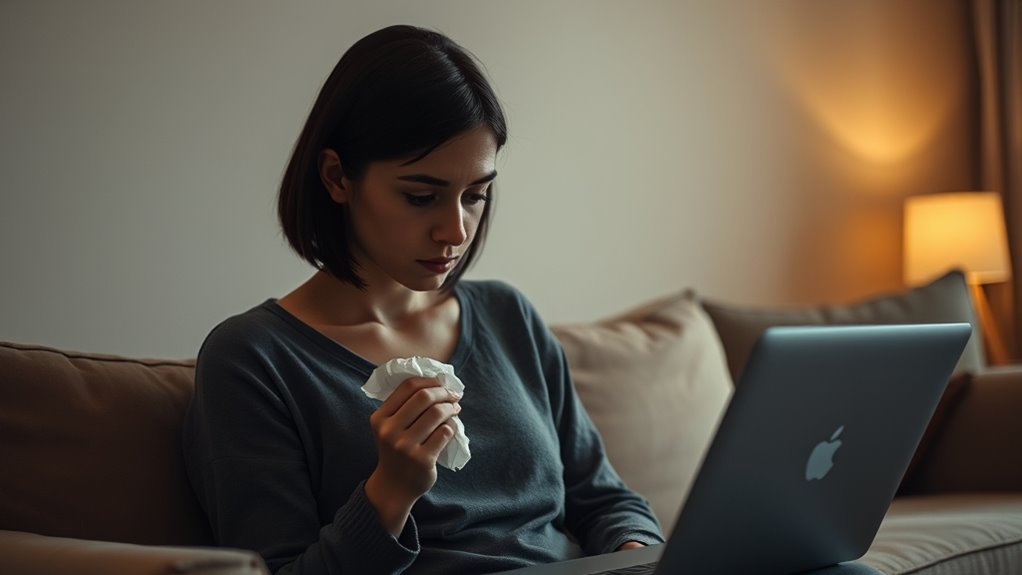Women are increasingly facing struggles with porn addiction, a problem often overlooked because of stereotypes that see it as a male issue. Many women turn to porn for emotional connection, escapism, or to explore their sexuality, often hiding their feelings out of shame. Privacy and easy access make it easier to develop unhealthy habits, while societal silence worsens the isolation. If you want to understand how these challenges affect women and what can be done, keep exploring this important topic.
Key Takeaways
- Women’s porn addiction is increasing due to accessibility, societal shifts, and emotional needs, challenging stereotypes that it’s only a male issue.
- Emotional factors like loneliness and desire for validation often motivate women’s porn use, differentiating their experience from men’s.
- Discreet access via smartphones and online platforms enables women to develop compulsive behaviors without societal judgment.
- Societal stereotypes lead to underrecognition and stigma, causing women to suffer in silence and avoid seeking help.
- Tailored awareness and support systems are essential to address women’s unique emotional and psychological challenges with porn addiction.

Have you ever wondered why women are increasingly struggling with porn addiction? It’s a question that many people overlook because society often associates pornography use with men. But the truth is, women are not immune. In fact, recent studies and reports reveal that women’s consumption of porn is rising, and so is the number of women battling unhealthy compulsions related to it. This shift is driven by multiple factors, including the accessibility of online content, changing attitudes toward sexuality, and the need for emotional intimacy or escape.
For women, porn addiction can be particularly complex. Unlike men, who might primarily seek visual stimulation, women often turn to porn for emotional connection, validation, or to explore their own sexuality in a safe, private way. This makes the addiction potentially more intertwined with underlying issues like loneliness, anxiety, or a desire for control. When these emotional needs aren’t met in real-life relationships, women may turn to pornography as a substitute, which can quickly spiral into a compulsive behavior. Additionally, the neurobiological factors affecting emotional regulation related to BPD can make it even more challenging for some women to control their impulses around such behaviors.
The pervasive presence of smartphones and the internet makes it easier than ever to access porn discreetly. For women who might feel shame or guilt about their desires, the anonymity offers a way to explore without judgment. Unfortunately, this privacy can also make it easier to develop unhealthy habits. As the consumption increases, it becomes harder to stop, especially because society rarely discusses women’s struggles with porn addiction openly. This silence leaves many women feeling isolated and misunderstood, which only fuels their reliance on the material.
Women’s experiences with porn addiction are often underestimated or dismissed because of stereotypes that suggest only men struggle with it. This misconception prevents many women from recognizing their own issue or seeking help. They may feel ashamed, fearing judgment or being labeled as “addicted,” which discourages open conversations. As a result, they suffer in silence, battling feelings of guilt and confusion.
Women often hide their struggles due to stereotypes and shame, suffering in silence.
Understanding that women face unique challenges with porn addiction is essential. It’s not just about breaking a habit; it’s about addressing emotional vulnerabilities and societal pressures that contribute to this struggle. Recognizing that women are affected differently can lead to better support systems, more tailored treatments, and a compassionate approach that encourages healing. Porn addiction isn’t solely a man’s problem—it’s a human issue that requires understanding, empathy, and action. Recognizing that content accessibility plays a significant role in this issue can help in developing effective prevention and intervention strategies.
Frequently Asked Questions
How Common Is Porn Addiction Among Women?
You might wonder how common porn addiction is among women. Research shows that while less frequent than men, women do struggle with compulsive viewing, with estimates suggesting around 3-5% experience problematic use. Factors like emotional triggers and accessibility contribute to this issue. Recognizing that women face this challenge helps break stereotypes and encourages seeking help. You’re not alone, and support is available if you or someone you know is affected.
Can Women Experience Physical Withdrawal Symptoms?
You might wonder if women experience physical withdrawal symptoms from porn addiction. The answer is yes; some women do. When you stop or reduce consumption, you may notice symptoms like irritability, anxiety, or cravings. These reactions are due to changes in brain chemistry, similar to other addictive behaviors. Recognizing these symptoms can help you better understand your experience and seek appropriate support or treatment.
Are There Specific Triggers Unique to Women?
While triggers for porn addiction may seem universal, women often face unique ones rooted in emotional intimacy and relational stress. Unlike men, who might be triggered by visual stimuli alone, women may find their urges sparked by feelings of loneliness, anxiety, or relationship conflicts. You might notice that emotional cues, like a fight or feeling rejected, prompt your desire to seek comfort through porn, highlighting these gender-specific triggers.
How Does Porn Addiction Affect Women’S Mental Health?
Porn addiction can substantially impact your mental health by causing feelings of shame, guilt, and anxiety. You might struggle with self-esteem issues or experience emotional numbness. It can also lead to increased stress and difficulty forming healthy relationships. Recognizing these effects helps you understand that seeking support is essential. Addressing the addiction can improve your emotional well-being and restore a sense of balance and self-worth.
What Role Do Societal Expectations Play in Women’S Addiction?
You might not realize it, but societal expectations markedly influence women’s addiction. Studies show that 65% of women feel pressured to meet certain beauty and sexual standards, which can lead to shame and secrecy around their behaviors. This pressure makes it harder to seek help, reinforcing addictive patterns. By understanding these societal roles, you can better address the root causes and support women in overcoming their struggles with porn.
Conclusion
Just like a storm that catches everyone off guard, porn addiction isn’t just a guy problem. Women face their own battles, often hidden in silence. Recognizing this struggle is the first step toward healing. Remember, you’re not alone in this fight—many women are steering through similar storms. With awareness and support, you can find clarity and strength. Don’t let shame be your anchor; instead, let understanding be your guiding light.









